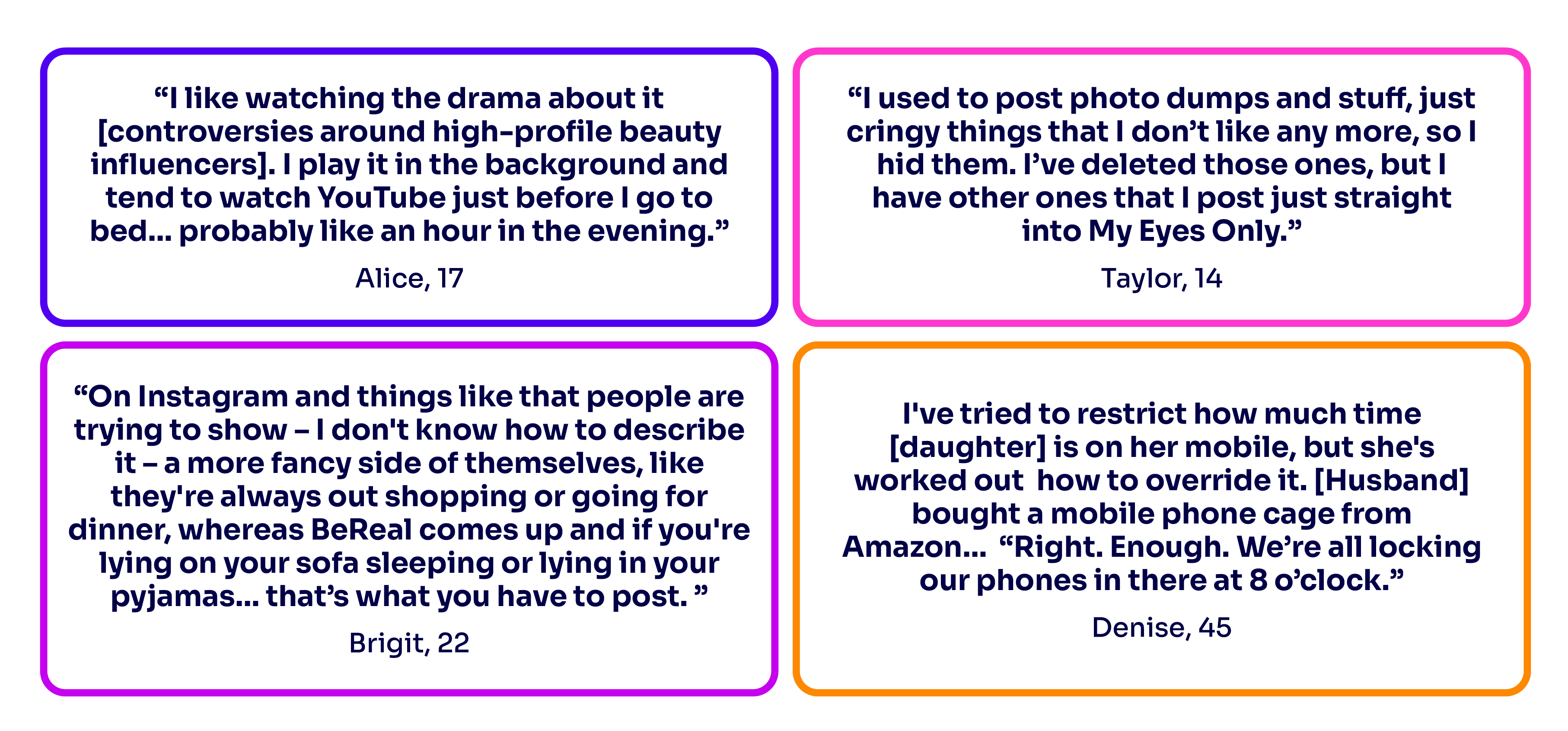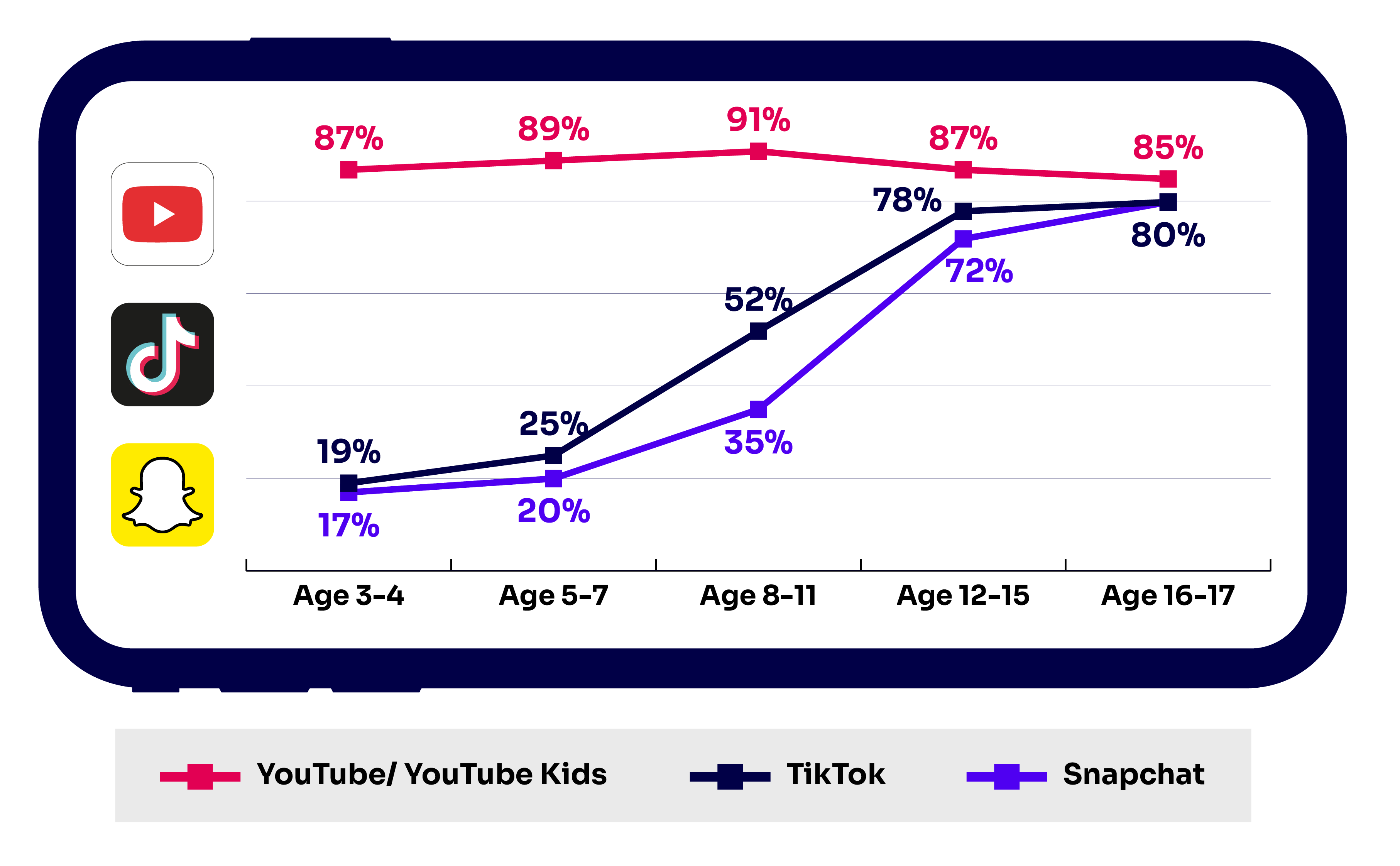
- Drawn to drama: Kids gravitate to dramatic, short-form videos on social media
- Rise of ‘split-screening’: Trend for watching two videos at once
- More careful, less creative: Youngsters more socially self-conscious, posting fewer videos.
- Screen time: 16–24-year-olds more likely to take social media break to manage wellbeing
Children are gravitating to ‘dramatic’ online videos which appear designed to maximise stimulation but require minimal effort and focus according to Ofcom’s annual study into children’s relationship with media and the online world.
Almost all children aged 3 to 17 (96%) watch videos on video-sharing sites and apps. More than half of all youngsters view live-streamed video content (58%), which increases to 80% among 16-17-year-olds.
YouTuberemains the most popular site or app, used by nearly nine in ten 3–17-year-olds (88%), although short-form video apps TikTok (50% to 53%) and Snapchat (42% to 46%) saw significant increases in use over the last year. [2]
Rivalries, reactions, rapidity – what makes a popular video
Much of the social media content consumed by the young participants in our latest Children’s Media Lives study can be characterised as ‘dramatic’ videos, engineered to grab and maintain their attention, but which require minimal effort and focus.
Gossip, conflict, controversy, extreme challenges and high stakes – often involving large sums of money – are recurring themes. ‘Commentary’ and ‘reaction’ video formats, particularly those stirring up rivalry between influencers while encouraging viewers to pick sides, were also appealing to participants.
These videos, popularised by the likes of Mr Beast, Infinite and JackSucksAtStuff, are often short-form, with a distinct, stimulating, editing style, designed to create maximum dramatic effect. This involves heavy use of choppy, ‘jump-cut’ edits, rapidly changing camera angles, special effects, animations and fast-paced speech.
The ‘split-screening’ appeal
This year also saw the rise of ‘split-screening’. Split-screen social media posts allow children to watch more than one short-form video simultaneously, on a single-screen, side-by-side or stacked on top of one another. This appears to be a progression of the ‘multi-screening’ behaviours seen in previous research waves, where children reported difficulties focusing on one screen-based activity at a time.
Sometimes the two split-screen videos watched by participants were related, such as influencers reacting and offering an opinion on real-world events. In other cases, the two videos had no obvious connection.
Social media… not all that social
Children are much less likely to post their own videos (32%) than to watch them (96%). Correspondingly, children in the Media Lives study said they are seeing less content created by their friends, and even when they do see it, are interacting with it less. For these children, social interaction between friends online is now primarily confined to chat apps or message functions within apps, rather than on public feeds.
With their social media feeds dominated by professionalised content, our Children’s Media Lives participants spoke about feeling increasingly self-conscious about how they portrayed themselves online – posting rarely, to limited circles, or not at all. Some children were creating edited or filtered videos and photos , but were saving them in their ‘drafts’, with no intention of ever posting them.
Striking the screen-life-wellbeing balance
Today’s research also includes a deep-dive into the online lives of older teenagers and young adults aged 16 to 24. This group are among the most avid online users, typically using nine online communication sites or apps on a regular basis – compared to six for the average adult internet user. Nearly nine in 10 (87%) use all four types of online communications – social media, messaging, video-sharing and live-streaming – significantly higher than the average user (61%).
As with younger children, Snapchat and TikTok have grown in popularity among 16-24s over the last year, overtaking Instagram as the social media platform they said they used most often. BeReal – an app which asks users to share, once a day, a real-life, unfiltered photo with friends – has also seen notable growth among this age group, with use increasing from 9% to 22% between spring and autumn 2022.
Just over half of social media users aged 16-24 (51%) thought they spent too much time on social media – up from 42% in 2021, and significantly higher than average (32%). But they are also setting boundaries. This group were significantly more likely than average to take a deliberate break from using any social media apps (36% vs. 25% average) or delete apps to avoid spending too much time on them (32% vs. 23% average).
Older teens and young adults are also generally more likely to seek out online content and services that support their wellbeing (89% vs. 78% of all online adults). Specifically, use of websites or apps designed to help with relaxation (44% vs. 34%), improve mood (43% vs. 26%), aid sleep (37% vs. 22%), manage anxiety (33% vs. 19%), follow a fitness programme or health-tracker (29% vs. 24%), meditate (21% vs. 15%) or feel energised (20% vs. 11%) was higher than average among this 16-24 age group of internet users.

Notes to editors
- Making Sense of Media is Ofcom’s programme of work to help improve the online skills, knowledge and understanding of UK adults and children. The research studies noted below are a core component of this programme.
Children and Parents: Media Use and Attitudes 2023: provides evidence on media use, attitudes and understanding among children aged 3-17 in the UK, as well as parents’ perspective of their child’s (age 3-17) media behaviours and the strategies they rely on to protect their child online. The tracker comprises three surveys: children’s online behaviour and attitudes, children’s online knowledge and understanding, and the parents-only survey.
- Children’s online behaviour and attitudes: fieldwork, 5-27 May 2022 (W1), 3-24 Nov 2022 (W2); sample 6,795 children aged 8-17 and parents of children aged 3-17; methodology, online panel
- Children’s online knowledge and understanding: fieldwork, 13 Oct-14 Nov 2022; sample, 2,087 children aged 8-17; methodology, online panel
- Parents only survey: fieldwork, 3 Oct-30 Nov 2022; sample, 2,526 parents of children aged 3-17; methodology, mix of online panels and post-to-web surveys
Children’s Media Lives 2023: provides a rich and detailed qualitative complement to Ofcom’s quantitative surveys of media literacy. It covers the motivations and context for media use and how media interacts with daily life and the domestic circumstances of the children in the study. It is a longitudinal study based on a sample of 21 children - as far as possible, it follows the same group of children aged 8 to 17, conducting filmed interviews with them each year to find out about their media habits and attitudes and how they might have changed.
The study uses a three-part methodology to incorporate actual as well as self-reported behaviour. It involves an initial 2-3 hour exploratory interview; the children recording their own media activities (completing a six-day media diary – which includes a daily ‘screen time’ data-grab from their smartphones, undertaking two 15-minute screen recording tasks and allowing the researchers to track their social media use over a two-week period); and, a final 45-minute follow-up interview during which the children reflect on their own media behaviours - i.e. the behaviours which have become apparent through the first two elements of the study.
Adults’ Media Use and Attitudes 2023: provides evidence on media use, attitudes and understanding among UK adults. The tracker comprises three surveys: the core survey, online behaviour and attitudes, and online knowledge and understanding.
- Core survey: fieldwork, Sep-Nov 2022; sample, 3651 adults aged 16+; methodology, mixed face-to-face and online panel
- Online behaviour and attitudes: fieldwork, April-May 2022 (W1) & Oct-Nov 2022 (W2); sample, 6100 online adults aged 16+; methodology, online panel
- Online knowledge and understanding: fieldwork, Oct-Nov 2022; sample, 3041 online adults aged 16+; methodology, online panel
Adults’ Media Lives 2023: provides a rich and detailed qualitative complement to Ofcom’s quantitative surveys of media literacy on the motivations and context for media use and how media interacts with daily life and the domestic circumstances of the adults in the study. It is a longitudinal, ethnographic project which has been running since 2005. The research follows 20 participants over time – with 12 of them having been in the study for at least 15 years – interviewing them at home to understand their relationship with digital media. This year, interviews of up to 90 minutes were mostly conducted face-to-face in home, with three interviews being held over Zoom.
- Use of YouTube/YouTube Kids is almost universal across children aged 3-17. TikTok and Snapchat are much more likely to be used by older children. Note these proportions are those that use these platforms, not that have a profile on them.

Child internet users using YouTube/TikTok/Snapchat in 2022
